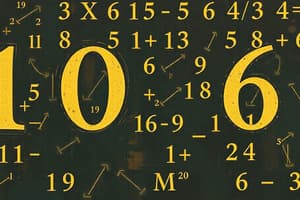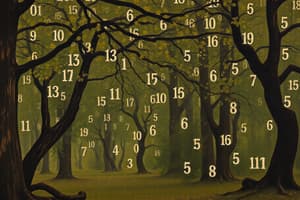Podcast
Questions and Answers
Explain the difference between the mean, median, and mode of a dataset. Provide an example to illustrate your explanation.
Explain the difference between the mean, median, and mode of a dataset. Provide an example to illustrate your explanation.
The mean is the average of a dataset calculated by summing all values and dividing by the number of values. The median is the middle value when the data is arranged in order. The mode is the most frequently occurring value in a dataset. For example, consider the dataset: 2, 4, 5, 5, 6, 7, 9. The mean is 5, the median is 5, and the mode is 5.
What is the domain of the function $f(x) = \frac{1}{x-2}$ and how do you determine it?
What is the domain of the function $f(x) = \frac{1}{x-2}$ and how do you determine it?
The domain of $f(x) = \frac{1}{x-2}$ is all real numbers except for $x=2$. This is because when $x=2$, the denominator becomes zero, which is undefined. To determine the domain, we need to identify any values of $x$ that would make the denominator zero.
Describe two different applications of trigonometry in real-world settings.
Describe two different applications of trigonometry in real-world settings.
Trigonometry is widely used in navigation to determine distances and directions based on angles and side lengths. It is also essential in surveying to accurately map land features and calculate distances and areas.
Explain why the formula for the area of a triangle is $\frac{1}{2}bh$, where $b$ is the base and $h$ is the height.
Explain why the formula for the area of a triangle is $\frac{1}{2}bh$, where $b$ is the base and $h$ is the height.
What is a function and what are its key characteristics?
What is a function and what are its key characteristics?
Describe a scenario where you would use the concept of subtraction in your daily life. Briefly explain why subtraction is the appropriate operation for this scenario.
Describe a scenario where you would use the concept of subtraction in your daily life. Briefly explain why subtraction is the appropriate operation for this scenario.
Explain the difference between rational and irrational numbers, providing an example of each.
Explain the difference between rational and irrational numbers, providing an example of each.
What is the purpose of factoring in algebra? Describe a scenario where factoring might be useful in solving an equation.
What is the purpose of factoring in algebra? Describe a scenario where factoring might be useful in solving an equation.
Explain the concept of congruence in geometry. Provide an example of two shapes that are congruent.
Explain the concept of congruence in geometry. Provide an example of two shapes that are congruent.
Explain the difference between a translation and a reflection in geometry. Briefly describe how each transformation affects a shape.
Explain the difference between a translation and a reflection in geometry. Briefly describe how each transformation affects a shape.
Describe the purpose of units of measurement. Why is it important to use standard units in measurement?
Describe the purpose of units of measurement. Why is it important to use standard units in measurement?
Explain the concept of a polynomial in algebra. Provide an example of a polynomial expression.
Explain the concept of a polynomial in algebra. Provide an example of a polynomial expression.
What is an inequality in algebra, and why is it important to understand its properties?
What is an inequality in algebra, and why is it important to understand its properties?
Flashcards
Addition
Addition
Combining two or more numbers to find their sum.
Subtraction
Subtraction
Finding the difference between two numbers.
Multiplication
Multiplication
Repeated addition of a number to find a total.
Division
Division
Signup and view all the flashcards
Natural Numbers
Natural Numbers
Signup and view all the flashcards
Rational Numbers
Rational Numbers
Signup and view all the flashcards
Polynomials
Polynomials
Signup and view all the flashcards
Geometric Transformations
Geometric Transformations
Signup and view all the flashcards
Data Analysis
Data Analysis
Signup and view all the flashcards
Statistical Measures
Statistical Measures
Signup and view all the flashcards
Functions
Functions
Signup and view all the flashcards
Trigonometric Functions
Trigonometric Functions
Signup and view all the flashcards
Trigonometry
Trigonometry
Signup and view all the flashcards
Study Notes
Basic Arithmetic Operations
- Addition combines two or more numbers to find their sum.
- Subtraction finds the difference between two numbers.
- Multiplication is repeated addition of a number.
- Division distributes a number into equal parts.
Number Systems
- Natural numbers (counting numbers) are positive integers starting from 1 (1, 2, 3...).
- Whole numbers are natural numbers and zero (0, 1, 2, 3...).
- Integers include whole numbers and their negative counterparts (...-3, -2, -1, 0, 1, 2, 3...).
- Rational numbers can be expressed as a fraction p/q where p and q are integers and q is not zero.
- Irrational numbers cannot be expressed as a fraction of two integers and have non-repeating, non-terminating decimals.
- Real numbers include both rational and irrational numbers.
- Imaginary numbers involve the square root of -1 (denoted as 'i').
- Complex numbers are combinations of real and imaginary numbers (a + bi, where 'a' and 'b' are real numbers).
Algebraic Concepts
- Variables represent unknown values.
- Expressions combine numbers, variables, and operation symbols.
- Equations show the equality of two expressions.
- Inequalities show relationships where two expressions are not equal.
- Polynomials are algebraic expressions with variables and coefficients combined through addition, subtraction, and multiplication.
- Factoring breaks down an expression into simpler expressions.
- Solving equations finds the variable value(s) making the equation true.
Geometry
- Geometry studies shapes, sizes, positions, and properties of figures in space.
- Basic shapes include points, lines, angles, triangles, quadrilaterals, polygons, circles, and three-dimensional shapes (cubes, spheres, cones).
- Geometric theorems describe relationships between shapes and their properties.
- Congruence describes identical shapes and sizes.
- Similarity describes shapes with the same angles but potentially different sizes.
- Geometric transformations include rotations, reflections, translations, and dilations.
Measurement
- Units of measurement quantify length, area, volume, and other object properties.
- Standard units (meters, centimeters, kilometers) are used for consistent measurement.
- Formulas calculate areas and volumes of different shapes.
Data Analysis
- Data analysis involves collecting, organizing, interpreting, and presenting data for conclusions or insights.
- Data is presented in various formats (tables, charts, graphs).
- Statistical measures (mean, median, mode) summarize data characteristics.
Functions
- Functions describe relationships between variables, where each input has a unique output.
- Functions are represented graphically, numerically, and algebraically.
- Key aspects of functions include domain, range, intercepts, and asymptotes.
- Types of functions (linear, quadratic, cubic, exponential, logarithmic) have unique properties and applications.
Trigonometry
- Trigonometry studies relationships between angles and sides of triangles.
- Trigonometric functions (sine, cosine, tangent) relate angles and sides in right-angled triangles.
- Trigonometric identities are equations true for all variable values.
- Applications include navigation, surveying, and engineering.
Studying That Suits You
Use AI to generate personalized quizzes and flashcards to suit your learning preferences.




